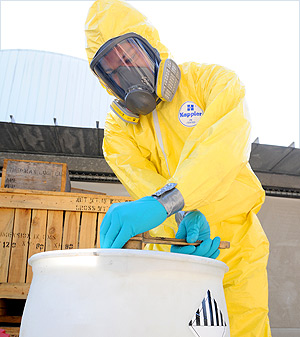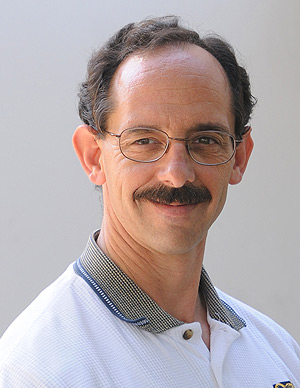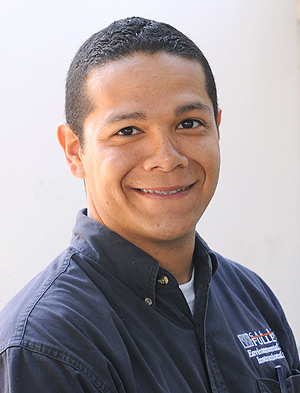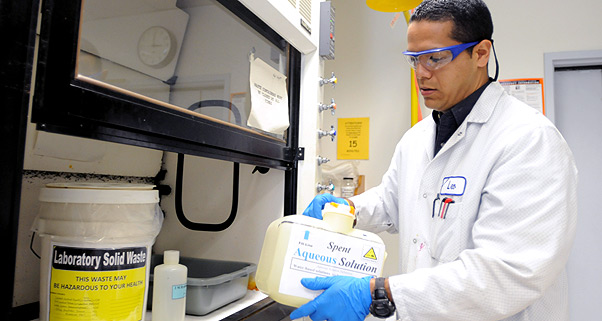Safe and Cost Efficient
New Method of Collecting Hazardous Waste Saves University Money
August 11, 2009
By Pamela McLaren

Leo Lopez wears protective gear, including respirator, when handling potentially toxic materials. In this photo he seals up a 55-gallon drum for disposal. Photo by Kelly Lacefield

Curtis Plotkin

Leo Lopez
What is Hazardous Waste?
Hazardous waste is any material — solid, liquid or gas — that can be considered dangerous — and is unwanted or ‘spent’: such as those things that are corrosive, toxic or bad for the environment.It’s pesticides, herbicides, depleted batteries, glues and adhesives, lubricants, paints, varnishes, stains, dry eraser fluid, art supplies or laboratory chemicals.
Where does it come from on a college campus?
It can come from just about anywhere. People immediately think of science labs where chemicals are used but hazardous waste also can come from offices that use batteries in clocks, glues, cleaners and similar materials that can’t be just tossed in the trash.Hazardous material is used in auto, paint or carpenter shops; engineering and art departments; greenhouses and grounds.
Asbestos can be in flooring and ceiling tiles or used as insulator on pipes. Cal State Fullerton has run an ongoing program to locate asbestos and to see to its safe removal.
Mercury is another hazardous material and its not found just in thermometers. Its also found in thermostats, fluorescent lights and other pieces of equipment. The campus now has a mercury replacement program that is working through campus replacing older model thermostats that contain the metal.
In a tough budget situation, two members of the Office of Environmental Health and Instructional Safety have found a way to save Cal State Fullerton thousands of dollars. If last year was a clue, Curtis Plotkin and Leo Lopez may bring in a cost savings of more than $100,000 this year.
Plotkin, environmental compliance manager, and Lopez, chemical hygiene officer, have looked at the way they were shipping hazardous waste from the campus and come up with an alternative method to manage the campus’ waste safely and save money.
Previously, Plotkin and Lopez would collect waste material, take it to the chemical storage area on campus, then call a contractor, who would come to the campus and ‘lab pack’ the hazardous chemical materials by class into metal drums. “Lab packing consists of placing small containers of waste, less than 5 gallons, into larger drums. Using this method, only about 25 gallons worth of material can be placed into a 55-gallon drum,” said Plotkin.
Now, they collect the material and take it to the chemical storage area, but before calling the contractor, “we run tests to determine if the chemicals are compatible and can be mixed together,” said Plokin.
“Instead of lab packing a large drum, we pour compatible materials from smaller containers into the drum. In this way, we can fill that drum almost to its full capacity,” said Lopez.
The new method reduces the amount of drums needed to properly dispose of campus waste from 560 to about 140 a year.
And the savings? Last fiscal year, it amounted to $90,000.
“And we expect to save even more this year,” said Plotkin.
Safety First
In order to process waste in this way, “you do need at least two trained technicians. Leo and I both have science degrees and specialized training in dealing with these materials,” said Plotkin, who has more than 15 years in environmental investigation, remediation and fieldwork in addition to a bachelor of science degree in geology from Cal State Dominguez Hills. “We understand the hazards and our first goal is, no matter what we do, do it safely. When we perform our tasks, we always use proper personal-protective equipment, follow the regulations and take the time to do it right.”
A member of the campus community since 2006, Plotkin previously worked with the California Environmental Protection Agency’s Department of Toxic Substances Control/Site Mitigation, as a remedial project manager at the agency’s Office of Military Facilities. Plotkin negotiated with the Department of Defense on the clean up of military bases, interfaced with other state agencies and reviewed and approved clean up technology, sampling and health and safety plans. Plotkin also worked as a manager of environmental health and as a field chemist in private industry.
Lopez, who joined the university in 2007 after earning a bachelor’s degree in chemistry from Cal State Long Beach, previously worked as an engineering technician/safety coordinator. “You can never let your guard down … stay alert to the hazards,” he stressed. “Not only is it the protective gear, its using caution to make sure that everything you do keeps the danger contained.”
Both men are certified in California Hazardous Waste Management Standards, hazardous waste operations, emergency response and other health and safety training. Lopez also has certification in dust control, storm water pollution control and prevention, laser safety and best practices for laboratory design.
“I couldn’t do this without Leo,” said Plotkin, who also is responsible for air quality compliance, environmental compliance and emergency response to a hazardous materials situation.
“Curtis is great to work with,” said Lopez, who oversees laboratory and laser safety and hazardous waste management. “I really enjoy what I do and promoting a healthy, safe and environmentally responsible campus is a task that I aim to perform every day that I set foot on campus.”
“The campus is fortunate to have such dedicated and innovative employees,” said Tom Whitfield, director of environmental health and instructional safety. “Curtis and Leo could have taken the easy approach and let the contractor do the work, but they decided to do their part to curtail campus expenses.”
For more information on the Office of Environmental Health and Instructional Safety, go to http://ehis.fullerton.edu/.


